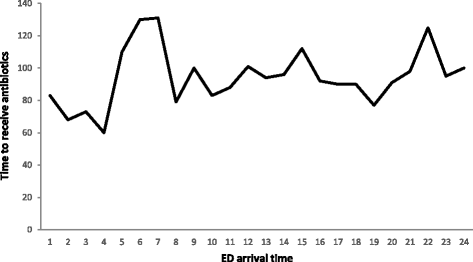Management and outcomes of patients presenting with sepsis and septic shock to the emergency department during nursing handover: a retrospective cohort study
- PMID: 29347908
- PMCID: PMC5774108
- DOI: 10.1186/s12873-018-0155-8
Management and outcomes of patients presenting with sepsis and septic shock to the emergency department during nursing handover: a retrospective cohort study
Abstract
Background: Clinical handover is an important process for the transition of patient-care responsibility to the next healthcare provider, but it may divert the attention of the team away from active patients. This is challenging in the Emergency Department (ED) because of highly dynamic patient conditions and is likely relevant in conditions that requires time-sensitive therapies, such as sepsis. We aimed to examine the management and outcomes of patients presenting with sepsis and septic shock to the ED during nursing handover.
Methods: This retrospective cohort study was conducted at a 115-bed ED and more than 200,000 annual ED visits, within a 900-bed academic tertiary care center. Data on Surviving Sepsis Campaign (SSC) bundle elements and hospital mortality were collected for all ≥14-year-old patients who presented to the ED with a diagnosis of sepsis and septic shock between January 1, 2011 and October 30, 2013. Our primary outcome was time to antibiotics, were other SSC bundle elements and mortality counted as secondary outcomes. Patients were divided into two groups: 1) handover time group, comprising patients who presented an hour before or after the start of handover time (6-8 AM/PM), and 2) non-handover time group, comprising patients who presented over the remaining 20 h.
Results: During the study period, 1330 patients presented with sepsis or septic shock (228, handover time group; 1102, non-handover time group). No significant differences were found between the handover time and non-handover time groups, respectively, in median time to antibiotic administration (100 [interquartile range (IQR) 57-172] vs. 95 [IQR 50-190] minutes; P = 0.07), median time to serum lactate result (162 [IQR 108-246] vs. 156 [IQR 180-246] minutes; P = 0.33) and median time to obtain blood culture (54 [IQR 36-119] vs. 52 [IQR 28-103] minutes; P = 0.52), and hospital mortality rate (29.4% vs. 28.9%; P = 0.89).
Conclusion: No significant differences were found in median time of SSC bundle elements or hospital mortality between patients who presented during the handover and non-handover times.
Keywords: Handover; Nursing; Sepsis.
Conflict of interest statement
Ethics approval and consent to participate
The study was approved by the Institutional Review Board of Ministry of National Guard-Health affairs, and given this study does not disclose patient identity and pose no risk to the patients the informed consent requirement was waived.
Consent for publication
Not applicable
Competing interests
The authors declare that they have no competing interests.
Publisher’s Note
Springer Nature remains neutral with regard to jurisdictional claims in published maps and institutional affiliations.
Figures
Similar articles
-
Arriving by emergency medical services improves time to treatment endpoints for patients with severe sepsis or septic shock.Acad Emerg Med. 2011 Sep;18(9):934-40. doi: 10.1111/j.1553-2712.2011.01145.x. Epub 2011 Aug 30. Acad Emerg Med. 2011. PMID: 21883637
-
Interhospital Transfer Delays Appropriate Treatment for Patients With Severe Sepsis and Septic Shock: A Retrospective Cohort Study.Crit Care Med. 2015 Dec;43(12):2589-96. doi: 10.1097/CCM.0000000000001301. Crit Care Med. 2015. PMID: 26491865
-
Mortality rate among patients with septic shock after implementation of 6-hour sepsis protocol in the emergency department of Thammasat University Hospital.J Med Assoc Thai. 2014 Aug;97 Suppl 8:S182-93. J Med Assoc Thai. 2014. PMID: 25518312
-
A quality improvement project to improve early sepsis care in the emergency department.BMJ Qual Saf. 2015 Dec;24(12):787-95. doi: 10.1136/bmjqs-2014-003552. Epub 2015 Aug 6. BMJ Qual Saf. 2015. PMID: 26251506 Review.
-
Does Early and Appropriate Antibiotic Administration Improve Mortality in Emergency Department Patients with Severe Sepsis or Septic Shock?J Emerg Med. 2017 Oct;53(4):588-595. doi: 10.1016/j.jemermed.2016.12.009. Epub 2017 Sep 12. J Emerg Med. 2017. PMID: 28916120 Review.
Cited by
-
Under the chest pain center mechanism, whether the nursing handover affects the nursing efficiency and the outcomes of patients with STEMI in the emergency department? A retrospective study.BMC Emerg Med. 2023 Jan 12;23(1):3. doi: 10.1186/s12873-023-00773-2. BMC Emerg Med. 2023. PMID: 36635636 Free PMC article.
-
Impact of intensive care unit admission during handover on mortality: propensity matched cohort study.Einstein (Sao Paulo). 2021 Jun 18;19:eAO5748. doi: 10.31744/einstein_journal/2021AO5748. eCollection 2021. Einstein (Sao Paulo). 2021. PMID: 34161436 Free PMC article.
-
Knowledge of Polish Nurses About Sepsis Based on Validated Questionnaire: A Multi-Site Cross-Sectional Study.Nurs Rep. 2025 May 30;15(6):195. doi: 10.3390/nursrep15060195. Nurs Rep. 2025. PMID: 40559486 Free PMC article.
-
Ubiquitin-independent degradation of Bim blocks macrophage pyroptosis in sepsis-related tissue injury.Cell Death Dis. 2024 Sep 30;15(9):703. doi: 10.1038/s41419-024-07072-z. Cell Death Dis. 2024. PMID: 39349939 Free PMC article.
References
MeSH terms
Substances
LinkOut - more resources
Full Text Sources
Other Literature Sources
Medical


